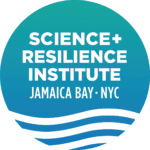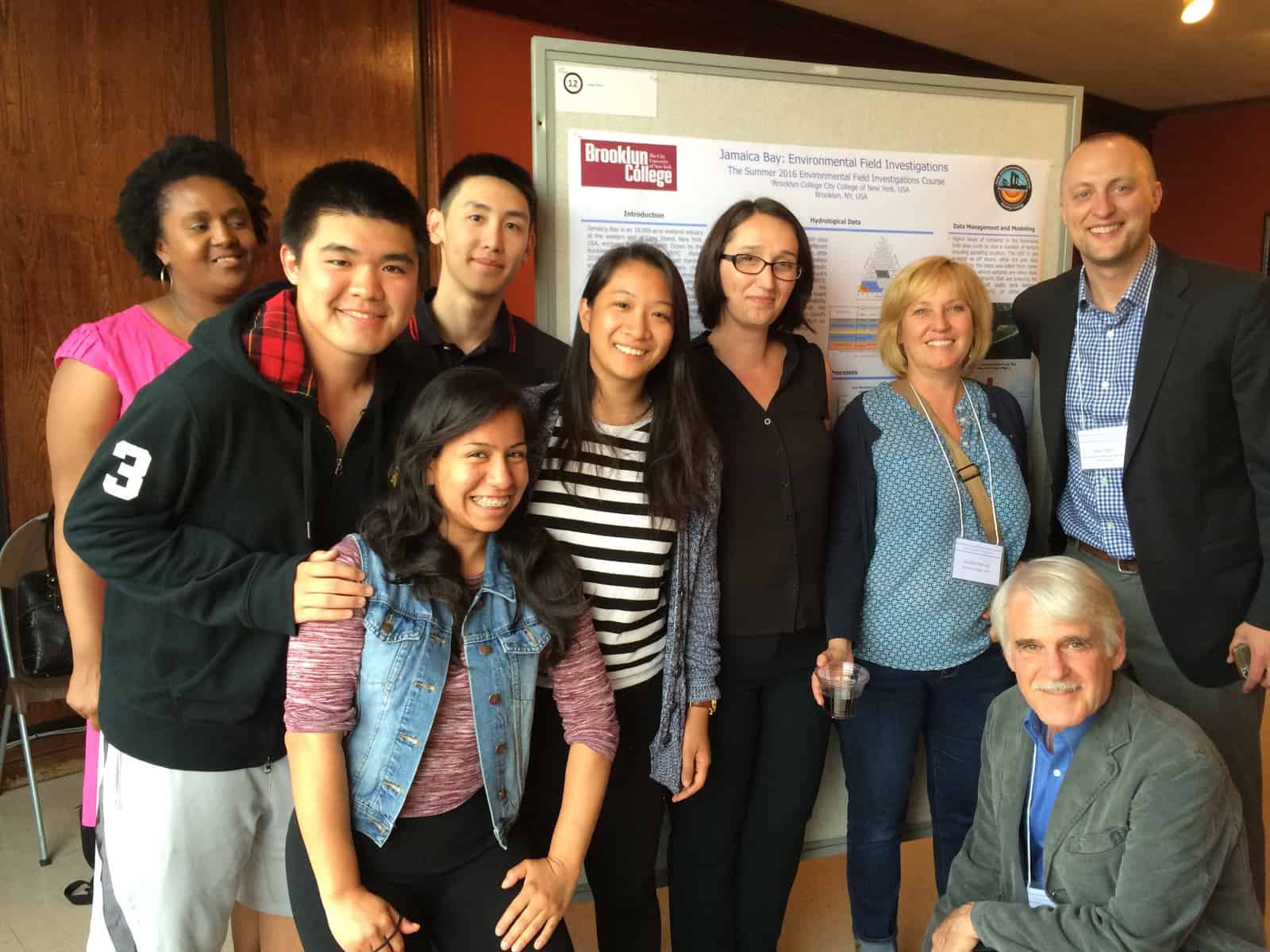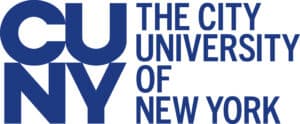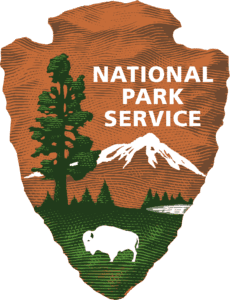Home | Symposium Program | Research Posters | Co-Chair and Speaker Biographies
The following list of Research Posters were featured during the Reception and Poster Session on Thursday, June 16, 2016 from 5:00 pm – 7:00pm at the Brooklyn College Student Center.
Click here to download as a pdf.
1) Recovery of Ecosystem Services following Wetland Restoration in Jamaica Bay
Authors: Mary Alldred1, Timothy Hoellein2, Denise Bruesewitz3, and Chester Zarnoch1
1City University of New York, Baruch College (New York, NY)
2Loyola University (Chicago, IL)
3Colby College (Waterville, ME)
Abstract: Coastal wetlands provide multiple ecosystem services including shoreline stabilization, flood and storm protection, and water purification. In Jamaica Bay, over 92% of historic wetland area has been lost over the past century. Currently, it is unclear if wetland restoration in eutrophic environments such as Jamaica Bay is sustainable over the long term, or if restoration will provide ecosystem services used to justify their construction costs. Because restoration efforts are ubiquitous and ongoing, it is important to assess the capacity for wetland restoration to provide ecosystem services. Past and ongoing restoration efforts in Jamaica Bay provide a unique opportunity to study nitrogen-removal ecosystem services in natural and restored wetlands in an urban, eutrophic environment. Here we present results of an ongoing study that seeks to determine the restoration age and environmental conditions under which salt-marsh restoration may become effective at providing ecosystem services such as nutrient sequestration in highly urbanized environments. Preliminary results, obtained using flow-through core incubations, indicate that restored marshes remove a significant amount of nitrogen via denitrification and that total nitrogen removal increases as restored marshes age. Across a chronosequence of restorations, ranging in age from 3 to 12 years, we detected increases in plant root mass, indicating that restored marshes also become more stable over time.
2) A Spatial and temporal analysis of water quality in Jamaica Bay: Detecting changes and establishing zones of similar influence
Authors: Danielle L. Alexander, Annesia L. Lamb, and Brett F. Branco
City University of New York, Brooklyn College (Brooklyn, NY)
Abstract: Jamaica Bay is an urban shallow estuary which receives high nitrogen loads from wastewater inputs. During the urbanization of New York City, changes in land use and wastewater inputs have likely contributed to changes in water quality. Long term monitoring in Jamaica Bay presents an opportunity to identify spatial and temporal water quality changes. Both the NYC Department of Environmental Protection (NYCDEP) and the National Park Service (NPS) have been monitoring a range of water quality parameters as early as 1909, providing a rich dataset. We obtained, formatted, and wrote metadata for the two data sets and used them to evaluate trends. There are no significant differences in mean water quality values between the agencies for co-located sampling stations. Additionally, a preliminary data analysis (at three sampling sites) indicates that while there are
statistically significant trends in several parameters, no significant water quality shifts were identified indicating a regime shift. A cluster analysis of mean summertime values for two different time periods (1995-1999,2009-2013) resulted in the spatial aggregation of 13 sampling areas into 4 zones of similar influence.
3) Coastal Storm Response: Surge, Wave, and Tide Hydrodynamic Network (SWaTH)
Author: William Capurso
United States Geological Survey
Abstract: Four years ago, Hurricane Sandy made landfall in southern New Jersey. In its immediate aftermath, the storm left a path of destruction that communities are still working to overcome. The massive size of the storm created a wind field that pushed ocean waters inland and caused significant flood damage.
The U.S. Geological Survey (USGS) embarked on an effort to build a new monitoring network that provides emergency managers and hurricane scientists with vital coastal storm-tide information during and after major storms affecting the Atlantic Coast.
Teams from USGS Water Science Centers from North Carolina to Maine pinpointed specific sites along the Atlantic Coast, determined their elevations and installed receiving brackets that will hold a network of sophisticated hydrological sensors that can be installed days-to-hours before a storm makes landfall. The network, will include approximately 700 locations from North Carolina to Maine.
4) Impact of Salt Marshes on Residence Time in Jamaica Bay, NY
Authors: Reza Marsooli1, Philip M. Orton1, Jim Fitzpatrick2, Nickitas Georgas1, and Alan F. Blumberg1
1Stevens Institute of Technology (Hoboken, NJ)
2HDR Inc., (Mahwah, NJ)
Abstract: Eutrophication – overabundance of nutrients in estuarine and coastal waters – depends not only on the supply of nutrients but also on the transport time scales such as residence time. Coastal wetlands can influence their surrounding hydrodynamic regime and, in turn, the residence time by changing circulation and flushing patterns. The sheltering effect of emergent vegetation influences the wind shear stress on the water surface and consequently the wind-driven mixing and circulation. Vegetation slows water movement and redirects currents into the tidal channels, influencing circulation and flushing patterns. Despite the significance of wetlands to water circulation and thus residence time, their effect on these processes has rarely been quantified. Here, we report on a series of model experiments that aims to quantify the influence of salt marshes on the residence time of water in Jamaica Bay, NY. As part of a project funded by the National Park Service, we have already implemented a vegetation module within the Stevens Institute of Technology Estuarine and Coastal Ocean Model (sECOM), considering the three-dimensional effects of vegetation on flow and turbulence quantities (Marsooli et al. 2016). We use sECOM and its conservative tracer-transport module to quantify the influence of Jamaica Bay’s present-day salt marshes on the residence time of several subdomains in the bay (e.g. Grassy Bay, Pumpkin Patch Channel, North Channel, and Beach Channel), as well as the bay as a whole. In this presentation, the experiment results will be presented and discussed.
5) The Nature of Social Resilience: Psycho-Social-Spiritual Benefits of Jamaica Bay
Authors: Heather McMillen, Erika Svendsen, Lindsay Campbell, Novem Auyeung, and Michelle
New York City Urban Field Station, US Forest Service (New York, NY)
Abstract: From remote villages to cosmopolitan megacities, people rely on nature. While the value of provisioning and regulating ecosystems services are well documented, cultural ecosystem services and their contributions toward well-being and social resilience are less understood, especially in densely-populated, urban areas.
Drawing from a larger study on the social value and meanings of NYC parklands and natural areas, we focus on Jamaica Bay and nature’s role in social resilience. We find that it supports well-being for a range of people who engage in practices that reflect personal desires to connect with nature and a larger reality, as well as via a broader set of practices focused on connecting with self and with others. To illustrate these concepts, we present a typology of spiritual symbols and materials and photographs of examples.
This research is a step toward better understanding interactions in complex social-ecological systems, specifically the intrinsic and intangible values of urban nature as they are co-created by parklands and park users. Our findings illustrate multiple intangible values of nature in an urban context which underscores the idea that human progress and nature conservation are not mutually exclusive. It is expected that resource managers and planners will expand their thinking about how to better manage Jamaica Bay and other parklands by making them accessible to and appropriate for populations that are diverse in culture, ethnicity, socio-economic status, and faith; but share a common need for exposure to and engagement with nature.
6) Calculating the rate of natural beach growth from U.S. Coast Survey charts
Authors: Mario Giampieri1,2 and Eric W. Sanderson2
1Massachusetts Institute of Technology, Department of Urban Studies and Planning (Cambridge, MA)
2Wildlife Conservation Society (Bronx, NY)
Abstract: Since the 1920s several interventions have been employed to stabilize the Rockaway Peninsula, including a jetty and groins; however, the peninsula remains part of the coastal barrier beach system of the south shore of Long Island, and as such is affected by longshore sediment transport and extreme weather events. This research aims to quantify the natural rate of sediment transport and beach accretion for the Rockaway Peninsula portion of the Long Island barrier beach system. High-resolution U.S. Coast Survey charts from the 19th and early 20th century were georeferenced and digitized using ArcGIS 10.2 to create digital elevation models of Rockaway Inlet at five different time points. A grid system was employed to quantify the change in sediment volume across the study area per unit area. Results show that the peninsula moved westward across Rockaway Inlet at a rate of 77 m/year throughout the 19th century, towards its present-day position. Understanding the natural rate of sediment transport and beach accretion will inform efforts to maintain beach health both on the Rockaway Peninsula and on Coney Island, the historical recipient of sediment travelling westward from the Rockaway Peninsula.
Corresponding author: Mario Giampieri, e-mail: mgiampieri@wcs.org, phone: (718) 741-1453
7) Modeling Pathogens for Oceanic Contact Recreation Advisories in the New York City Area using Total Event Simulations
Authors: Bin Wen and Nickitas Georgas
Stevens Institute of Technology (Hoboken, NJ)
Abstract: A simulation of transport and fate of pathogen indicators in the New York City (NYC) open waters was run using a coupled model for four 4-month periods. Combined Sewer Overflow (CSO) discharges into NYC were simulated as the main source of pathogen pollution using RCA-Pathogens and the New York Harbor Observing and Prediction System (NYHOPS).
Modeled concentrations for enterococci in receiving waters were extracted from the model and compared with NYC beach observations and NYC Harbor Surveys to validate and bias-correct the result. Results showed that model has well simulated the growth and die-off process of pathogens. Receiving water Enterococci concentrations grew responsively to rainfall, and decreased notably after rainfall. Comparing the model results to observations, the average deviation coefficient is -0.27 throughout all NYC beaches, and -0.19 throughout all NYC waterbodies.
Bias-corrected results were then used to calculate model-based contact recreation advisories and compare to existing rainfall-based advisories: NYCDEP advisory guidance for waterbodies, DOHMH advisory guidance for NYC beaches. The calculated model-based advisories has involved consideration of complexity of local circulation, and the advisory results are conservative in most cases. The total number of modeled advisory days is 1.3 times of the total advisory days based on current DOHMH guidance for NYC beaches, and is 2.5 times of total advisory days based on NYCDEP guidance for NYC waterbodies.
8) Determining the most Suitable Habitat for Ulva Blooms in Jamaica Bay using a Geospatial Model
Authors: Kristine Erskine and Rebecca Boger
CUNY Brooklyn College (Brooklyn, NY)
Abstract: This research project is aimed at creating a Habitat Suitability Model for Ulva species in Jamaica Bay. Because extreme Ulva growth is an indicator of a eutrophic ecosystem; the model will be used to predict where Ulva can be found so that better management strategies can then be employed. Parameters for the model include water quality measurements, i.e., average nitrate concentration, dissolved oxygen, temperature, pH, salinity, conductivity, depth of the water column, secchi depth, Photosynthetically Active Radiation (PAR), light transmissivity and bathymetry. Because model validation will use remote sensed data and historical aerial photographs taken at low tide (for 2014 and 2015 models); and predictive validation for 2017 models will be based on low altitude Unmanned Aerial Vehicle Photography (UAV); these databases will be made public through CUNY Academic Commons. It will serve as an initial data sharing forum for estuarine researchers and students who study Ulva blooms in Jamaica Bay. The most innovative aspect of this research is the publicizing of the template of the final validated model, again through the CUNY Academic Commons. Here, it can be accessed by similar communities to monitor aquatic ecosystems for suitable Ulva habitats as an indication of increased eutrophic and unhealthy aquatic conditions.
Corresponding author: Kristine Erksine, email: kerskine@gradcenter.cuny.edu phone: (347) 623-5499
9) The U.S. Geological Survey’s Sediment-bound Contaminant Resiliency and Response Strategy: A Tiered Multi-metric Approach to Environmental Health and Hazards in the Northeastern USA
Authors: Reilly, Timothy J., Focazio, Michael J., Murdoch, Peter S., Benzel, William M., Fisher, Shawn C., Griffin, Dale W., Iwanowicz, Luke R., Jones, Daniel K., and Loftin, Keith A.
United States Geological Survey
Abstract: Enhanced dispersion and concentration of contaminants such as trace metals and organic pollutants through storm-induced disturbances and sea-level rise are major factors that could adversely impact the health and resilience of communities and ecosystems. As part of the response to Hurricane Sandy, the U.S. Geological Survey collected data on the effects of contaminant source disturbance and dispersion. A major limitation of conducting pre- and post-Hurricane Sandy comparisons was the lack of baseline data in locations proximal to potential contaminant sources and mitigation activities, sensitive ecosystems, and recreational facilities where human and ecological exposures are probable. To address this limitation, a Sediment-bound Contaminant Resiliency and Response (SCoRR) strategy with two operational modes, Resiliency (baseline) and Response (event-based), has been designed. In Resiliency Mode, sites are identified and sampled using standardized procedures prioritized to develop baseline data and to define sediment-quality-based environmental health metrics. In Response Mode, a subset of sites within the network is evaluated to ensure that adequate pre-event data exist at priority locations. The first set of baseline data collection (180 sites from Maine to Virginia) began in July 2015, and in October 2015, crews suspended baseline sampling and deployed in response to Hurricane Joaquin. Select sites were resampled, allowing direct evaluation of impacts and to redefine baseline conditions for these areas. Results will identify vulnerable human and environmental receptors, quantify contaminants present, and evaluate biological activity and potential effects of exposure to characterized sediments. Data and metrics are being provided via the SCoRR Web site and mapper.
(http://toxics.usgs.gov/scorr/index.html).
10) Groundwater Monitoring by the U.S. Geological Survey on Long Island, New York
Authors: Michael D. Como, Simonette Rivera, and Ronald Busciolano
United States Geological Survey
Abstract: The U.S. Geological Survey (USGS), in cooperation with State and local agencies, systematically collects groundwater data at varying measurement frequencies to monitor the hydrologic conditions on Long Island, New York. Each year during April and May, the USGS conducts a synoptic survey of water levels to define the spatial distribution of the water table and potentiometric surfaces within the three main water-bearing units underlying Long Island — the upper glacial, Magothy, and Lloyd aquifers — and the hydraulically connected Jameco and North Shore aquifers. These data and the maps constructed from them are commonly used in studies of Long Island’s hydrology and are utilized by water managers and suppliers for aquifer management and planning purposes.
Maps and geospatial datasets were recently published for the 2013 synoptic. These products included water-level data surrounding Jamaica Bay and indicate the direction of groundwater flow and areas prone to groundwater flooding. Understanding the nature of groundwater flow into Jamaica Bay is important because groundwater can be a significant source of nitrogen loading to estuaries. Long-term hydrologic monitoring by the USGS is ongoing in Nassau and Suffolk Counties, but was suspended for New York City at the end of 2013 due to a lack of cooperator funding.
11) Monitoring and Evaluation of Recovery and Resilience: Dune-Beach Geomorphology of Breezy Point Tip and West Pond, Jamaica Bay
Authors: Joshua Greenberg1, Katherine Ames1,2, William J. Schmelz1, Andrea Spahn1, Dr. Norbert P. Psuty1
1Sandy Hook Cooperative Research Programs, NJAES, Rutgers University
2Corresponding author
Abstract: Coastal ecosystems and their associated geomorphological formations are in a state of flux; sediment availability, coastal processes, and anthropogenic influences all have an effect on the dynamics of dune-beach systems at multiple scales, evidenced by erosional and depositional forms. Particularly in highly populated areas such as New York City, detailed knowledge of the state of these coastal systems are of high value to a variety of stakeholders including scientists, managers, and the public.
Using geodetic GPS units, we map the surface elevation of ten dune-beach systems throughout Jamaica Bay. These sites are chosen not only for their characteristic geomorphologies, but represent locales exposed to different wave energies, sediment availabilities, and varying degrees of anthropogenic influence. Here, we describe the geomorphological evolution at Breezy Point Tip and West Pond from July 2010 through May 2016, and how both have recovered after Hurricane Sandy.
Since Hurricane Sandy, the beach at Breezy Point Tip has accumulated. There are also several erosional bands throughout the upper berm and dune portions of the site. Together, these changes result in a total volumetric gain of 91,000 m3 for the November 2012-May 2016 time period. The changes at West Pond are characterized by erosional zones in the eastern and western portions of the site and one major area of deposition in the center, resulting in a total volumetric change of ‑2,800 m3 for the July 2010-May 2016 time period.
12) Assessing the Microbial Biodiversity from Salt Marsh Sediment at Various Stages Post-Restoration
Authors: Nathan Morris, Elizabeth Alter
CUNY York College (Jamaica, NY)
Abstract: The salt marshes of Jamaica Bay provide an important role in both the ecosystem function and in the resilience of the bay. Due to rapid salt marsh loss over past decades restoration projects have begun in order to mitigate loss and rebuild. A broader understanding of the impact of restoration has on underlying ecological processes and biodiversity found within these marshes is greatly needed. One aspect of the Jamaica Bay’s salt marsh ecology that is not currently understood is how the biodiversity of microbial communities from sediment vary in salt marshes that are in different states of health. Understanding this biodiversity is key to the understanding salt marsh ecosystem function and resilience as a whole. Here, using the 16S barcoding gene we describe microbial community diversity and taxonomic composition found within sediment taken from five salt marsh locations within Jamaica Bay. Four of these sites exhibit a post-restoration gradient ranging from three to twelve years, and one from a site that remains unrestored. By comparing the microbial community structure and levels of diversity, found in restored marshes, to those found in unrestored or degrading marshes, we hope to begin to link community composition with ecosystem health. This will help to complete our understanding of a healthy salt marsh and how they relate to the resilience of the bay.







